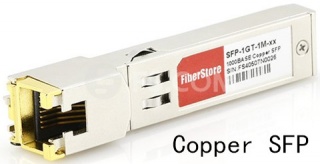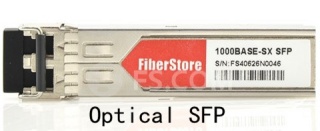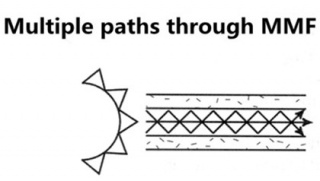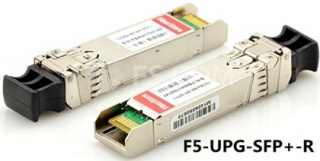Copper & Optical SFP Modules
srijeda , 25.05.2016.In order to maintain the configuration flexibility and establish connections that allow smooth data transfer from the source to the end point, SFP transceiver modules are utilized in the copper or optical Gigabit Ethernet (GbE) networks. SFP (Small Form-factor Pluggable) is a compact, hot-swappable, input/output device used in data communication and telecommunications networks. SFP interfaces between communication devices like switches, routers and fiber optic cables, performing optical and electrical signal conversion. There are many copper an optical SFP transceivers based on different GbE physical layers, such as Cisco 1000BASE-T SFP-GE-T and 1000BASE-SX SFP MGBSX1.
GbE Development
The initial standard for GbE was produced by the IEEE in June 1998 as IEEE 802.3z. Two designs were ratified in IEEE 802.3z to transmit signals over optical cables: the 1000BASE-SX uses short-wavelength laser (850nm) on multi-mode fiber (MMF), and the 1000BASE-LX uses long-wavelength laser (1310nm) on the standard single-mode fiber (SMF). At that time, transmitting 1000Mbps signals on the widely deployed Category 5 UTP was a significant challenge for silicon-chip designers. It requires tremendous signal processing to mitigate the channel impairments in copper wires such as ISI (intersymbol interference) introduced by limited channel bandwidth and signal crosstalks between pairs of copper wires. It was not until a year later that the 1000BASE-T standard (IEEE 802.3ab) was finished. To keep the cost of GbE low, the IEEE 802.3z committee very conservatively defined the transmission distance limit of 1000BASE-SX as 300m, and that of 1000BASE-LX as 5 km.
SFP Port Types
Specified by the Multisource Agreement (MSA), SFP, also known as a mini gigabit interface converter (GBIC), delivers the similar functions just as what a GBIC does, but designed with a much smaller size. As mentioned above, SFP transceiver has several interfaces which are standardized to work on SMFs and MMFs. Besides, SFP transceivers are also available with copper cable interfaces, like 1000BASE-T. This means that SFP module which is designed primarily for optical fiber communications can also communicate over unshielded twisted pair (UTP) cables. The image below shows different GbE SFP standards.
Copper SFP Modules
The development of copper technology in SFP modules is of great importance in enabling system designers to meet objectives while simplifying their inventory and reducing operating costs. These copper SFP transceivers scale Ethernet 10/100Mbps performance to 1000Mbps. Compared with 1Gbps, 1000BASE-T is 100 times as fast as the standard Ethernet. Additionally, the Full Duplex Repeaters (FDRs), when coupled with 1000BASE-T, offer an easy-to-manage, high-burst rate, and shared-media solution capable of supporting both end users and server farms. Popular copper SFP products, like Cisco SFP-GE-T, are used in Gigabit networks and they are fully compatible with 1000Base-T.
Optical SFP Modules
Both 1000BASE-SX and 1000BASE-LX are standardized for fiber optics. They share the 8B/10B 1000BASE-X PCS line coding. In addition to the transmission media, the only difference between 1000BASE-SX and 1000BASE-LX lies in the physical medium dependent (PMD) layer which defines the laser transmitter and photodetector. The interface between the physical medium attachment (PMA) and PMD layer is simply a serial interface. This made it easy to reuse all the designs between 1000BSAE-SX and 1000BASE-LX except the PMD transceiver.
Modern optical SFP modules support digital diagnostics monitoring (DDM) functions, also known as digital optical monitoring (DOM). This feature gives users the ability to monitor the real-time parameters of SFP, such as optical output power, optical input power, temperature, laser-bias current and transceiver supply voltage. The real-time diagnostic parameters can be monitored to alert the system when the transceiver’s specified operating limits are exceeded and compliance cannot be ensured. What’s more, the DDM function can be used to isolate the particular location of fault in fiber optic network system. Combining the DDM interface status flags, transceiver hard pins and diagnostic parametric monitor data the specific location and cause of a link failure can be pinpointed. Certainly, DDM function also has its role in failure prediction on fiber optic links, which is based on the transceiver parametric performance., including device faults and high error rate conditions.
SFP Module Applications
Apart from GbE, SFP modules can also support other communications standards, including synchronous optical networking (SONET)/synchronous digital hierarchy (SDH), and fiber channel. They allow the transport of fast Ethernet and GbE LAN packets over time-division-multiplexing-based WANs, as well as the transmission of E1/T1 streams over packet-switched networks.
SFP Purchasing Tips
When picking such a SFP module for your network, the first important factor to be considered is the price, especially for those small and medium-sized enterprises who have a tight budget. The other points go to the product compatibility, stability, and reliability. Otherwise, no matter how low the price is, it’s of no use.
Conclusion
Copper and optical SFP modules have proven themselves as the useful devices for the increased bandwidth requirements of users with each passing day. Fiberstore supplies a wide range of SFPs to support both copper and optical interfaces. They are fully compatible with such famous brands as Cisco, Juniper, D-Link (ie. DEM-311GT). Here just lists a few for your reference. For more information about SFP modules, you can visit Fiberstore directly.
Oznake: GbE, SFP, 1000BASE-T, SFP-GE-T, 1000BASE-SX, MGBSX1, DEM-311GT, 1000BASE-LX
komentiraj (0) * ispiši * #
Four Aspects About Multi-mode Fibers
petak , 20.05.2016.Data centers are never ceased their steps to bring greater speed and efficiency to telecommunication and datacoms industries. An enormous amount of data is transmitted, gathered and analyzed everyday, all which requires a vast number of high-bandwidth interconnections between data centers, and people. During these interconnections, fiber optic cables see their heaviest use.
Fiber optic cables can deliver more bandwidth for voice, video and data applications, and carry thousands of times more information than copper wire. With fiber optic cables, reliable and secure data transmission is ensured. Fiber optic cables are available in single-mode and multi-mode versions based on transmission mode standard. This article puts its focus on the latter version: multi-mode fiber (MMF), discussing MMF from its core size attenuation, bandwidth and manufacturing ways.
MMF: Larger Core Size
It’s known that MMF has a much larger core size and cladding diameter, whose different types are distinguished by jacket color: for 62.5/125 µm (OM1) and 50/125 µm (OM2), orange jackets are recommended, while aqua is recommended for 50/125 µm "laser optimized" OM3 and OM4. MMF’s larger core endows it greater light gathering capacity, allowing multiple modes of light to propagate through the fiber simultaneously. Thus, MMF is more suitable for relatively shorter-reach application, usually less than 600m. When it’s deployed in GbE applications, the maximum reach is 550m in combination of 1000BASE-SX SFP (ie. 1783-SFP1GSX).
MMF: Attenuation/Signal Loss
Attenuation refers to the reduction of signal loss when light travels through the fiber optic cable, which is measured in decibels per kilometer (db/km). Insertion loss is the total attenuation from all sources plus any reflection losses over a specific fiber length. Such attenuation is often caused by absorption of optical energy by tiny impurities in the fiber such as iron, copper, or cobalt. Sometimes, the scattering of the light beam as it hits microscopic imperfections, called Rayleigh scattering can also lead to signal loss phenomenon. Attenuation problem is a commonplace in MMFs.
MMF: More Bandwidth
Bandwidth quantifies the complicated data-carrying capacity of MMF, given in units of megahertz-kilometer (MHz·km). Bandwidth behavior of MMF arises from multi-modal dispersion (multi-path signal spreading) which happens as the result of light traveling along different modes in the core of fibers. The bandwidth specification of performance of a MMF is verified through optical measurements during fiber manufacture. Actual system performance and data-rate handling rely heavily on bandwidth, affected by transceiver technology and device characteristics.
MMF: Manufacturing Ways
MMF can be manufactured in two ways: step-index or graded index.
Step-index fiber has an abrupt change or step between the index of refraction of the core and the index of refraction of the cladding. Multi-mode step-index fibers have lower bandwidth than other fiber designs.
Graded index fiber is designed to reduce modal dispersion inherent in step index fiber. This design maximizes bandwidth while maintaining a larger core diameter for simplified system assembly, connectivity and lower network costs. Graded index fiber is made up of multiple layers with the highest index of refraction at the core. Each succeeding layer has a gradually decreasing index of refraction as the layers move away from the center. High order modes enter the outer layers of the cladding and are reflected back towards the core. Multi-mode graded index fibers have less attenuation (loss) of the output pulse and have higher bandwidth than multi-mode step-index fibers.
MMF related transceivers: Multi-mode Transceivers
A fiber optic transceiver is a package, usually a pluggable module, comprising of a receiver on one end of the fiber and a transmitter on the other end. Over the years, multi-mode bandwidth specifications and measurement methods have evolved along with the transceiver technology, so as to keep up with delivery of higher transmission speeds. The combination of transceiver and fiber optic cable plays an important role in fiber’s practical link length. As for multi-mode transceivers which have larger core, they are often used in short-reach applications with 850mn wavelength. Listed below are several commonly-used multi-mode transceiver ports: 1000BASE-SX, 10GBASE-SR, 10GBASE-LRM, among which 10GBASE-SR port type enjoys widely deployment in 10GbE applications when the required distance is not so long. Take F5-UPG-SFP+-R for example, this F5 compatible 10GBASE-SR SFP+ transceiver listed in Fiberstore takes OM3 MMF as its transmission medium for 300m reach.
Besides what have been discussed above, there is also another MMF feature that comes into your mind: that is the affordability. MMF is less expensive than its counterpart single-mode fiber (SMF). Because of this, more people prefer MMF to SMF when the required distance is not so long. Thus, this big saving can be re-invented in other projects.
Conclusion
MMF is able to operate at data rates from 100Mbit/s to 1Gbit/s, to 10Gbit/s, to 40Gbit/s, to100Gbit/s, or even more. Choosing the right fiber type for your network project is a critical task. Here, Fiberstore MMFs provide the cost-effective combination of leading bandwidth performance and increased reliability, suitable for the demanding bandwidth interconnects. You can visit Fiberstore directly for more information about MMFs.
Oznake: MMF, Multi-mode Transceivers, 1000BASE-SX, 1783-SFP1GSX, 10GBASE SR, F5-UPG-SFP+-R
komentiraj (0) * ispiši * #
Consider Two Things Before Deploying 10 Gigabit Ethernet
utorak , 08.03.2016.Over the years, Ethernet technologies have evolved rapidly and amazingly to meet the never-ceasing requirements of higher bandwidth and faster data transmission speeds for high quality network applications, such as live video and video download with high resolution. Through this great evolution, Ethernet technology standards have been designed, like 10 Gigabit Ethernet (GbE).
After IEEE Standard 802.3ae- 2002 for 10GbE was ratified several years ago, some enterprises have begun to deploy 10GbE in their data centers to support bandwidth-needing applications. Before deploying 10GbE, as matter of fact, there are many things that should attract your attention. Here this article lists two important things you need to consider for a reliable 10GbE deployment: 10GbE cabling choices, and 10GbE transceiver types.
10GbE Cabling Choices
Along with the technological revolution, cables used for transmission also experienced progressive development. There are two physical media available for 10GbE transmission: fiber and copper.
10GbE Fiber Cabling Choices
Fiber cables fall on two classifications: single-mode fiber (SMF) and multi-mode fiber (MMF). In SMF, there is only one path for light, while in MMF light flow through multiple paths. SMF is intended for long distance communication and MMF is used for distances of less than 300 m. Commonly used 10GbE ports designed for SMF are 10GBASE-LR, 10GBASE-ER and 10GBASE-ZR, and the ports specified for MMF are 10GBASE-SR and 10GBASE-LRM. It’s of great importance to choose these ports 10GbE transmission when link lengths matter. For example, you can choose a J9150A transceiver when the required distance is less than 300m. In a word, the form factor options depend on your link lengths.
10GbE Copper Cabling Choices
As the structured cabling techniques become mature, copper cabling technology also grasps the chance to develop itself. And more and more people start to choose copper cables as the medium for 10GbE transmission. 10GBASE-T and SFP+ direct attach cables (DAC) standards symbolize copper applications.
10GBASE-T, or IEEE 802.3an-2006, is a standard released in 2006 to provide 10Gbit/s connections over unshielded or shielded twisted pair cables, over distances up to 100 metres (330 ft). It requires the Cat 7 or Cat 6A to reach 100 meters, but can still work on Cat 6, Cat 5E, or even Cat 5 cable when reduced distances are required.
SFP+ DAC is the latest standard for optical transceivers, and it connects directly into an SFP+ housing. In SFP+ DAC cabling assembly, no optical transceiver is used at each end. A cable was invented with each end physically resembling a SFP+ transceiver, but with none of the expensive electronic components. This creation is known as DAC. Actually, besides 10GbE applications, DAC is also considered as a cost-effective solution to replace fiber patch cables sometimes in 40GbE systems. Like QSFP-H40G-ACU10M, this Cisco 40G cabling product is the QSFP to QSFP direct attach passive copper cable assembly designed for 40G links.
10GbE Transceiver Types
After choosing cables, you need to select devices that connect these cables to your networks. These devices are transceivers. 10GbE has four transceiver types: XENPAK (and related X2 and XPAK), GBIC, SFP and SFP+.
XENPAK is a Multisource Agreement (MSA) that defines a fiber-optic or wired transceiver module which conforms to the 10 Gigabit Ethernet (10GbE) standard of the Institute of Electrical and Electronics Engineers (IEEE) 802.3 working group.
GBIC stands for Gigabit Interface Converter. It is a common type of optical transceiver module which converts serial electric signals into serial optical signals and vice versa. The GBIC is typically employed in fiber optic and Ethernet systems as an interface for high-speed networking. Common applications include Fibre Channel and Gigabit Ethernet.
SFP (small form-factor pluggable) can be regarded as the upgrade version of GBIC module. Unlike GBIC with SC fiber optic interface, SFP is with LC interface and the main body size of SFP is only about half of GBIC so that it can save more space. There are several types of SFP modules, SX, LX, EX, etc. Among them, 1000BASE-SX SFP is the most widely used. This type works with multi-mode fiber (MMF) for linking. When used with 62.5 micron MMF, its max-working span is around 220 meters, while when used with 50 micron MMF, its max-working span is around 550 meters. Fiberstore compatible Cisco SFP-GE-S product is designed to realize 550 -meter reach through 50 micron MMF.
SFP+, also called SFP Plus, is short for enhanced small form-factor pluggable, an enhanced version of the SFP that supports data rates up to 16Gbit/s.
Conclusion
After discussion, maybe you have obtained a better understanding of 10GbE cables and transceivers, which helps you to better choose the right devices for your 10GbE applications. Fiberstore supplies various numbers of 10GbE cables and transceivers which are quality assured. For more information about 10GbE solutions, you can visit Fiberstore directly.
Originally published at www.fiber-optic-components.com/consider-two-things-before-deploying-10-gigabit-ethernet.html
Oznake: 10GbE cabling, SFP+ DAC, QSFP-H40G-ACU10M, SFP, 1000BASE-SX, SFP-GE-S
komentiraj (0) * ispiši * #







